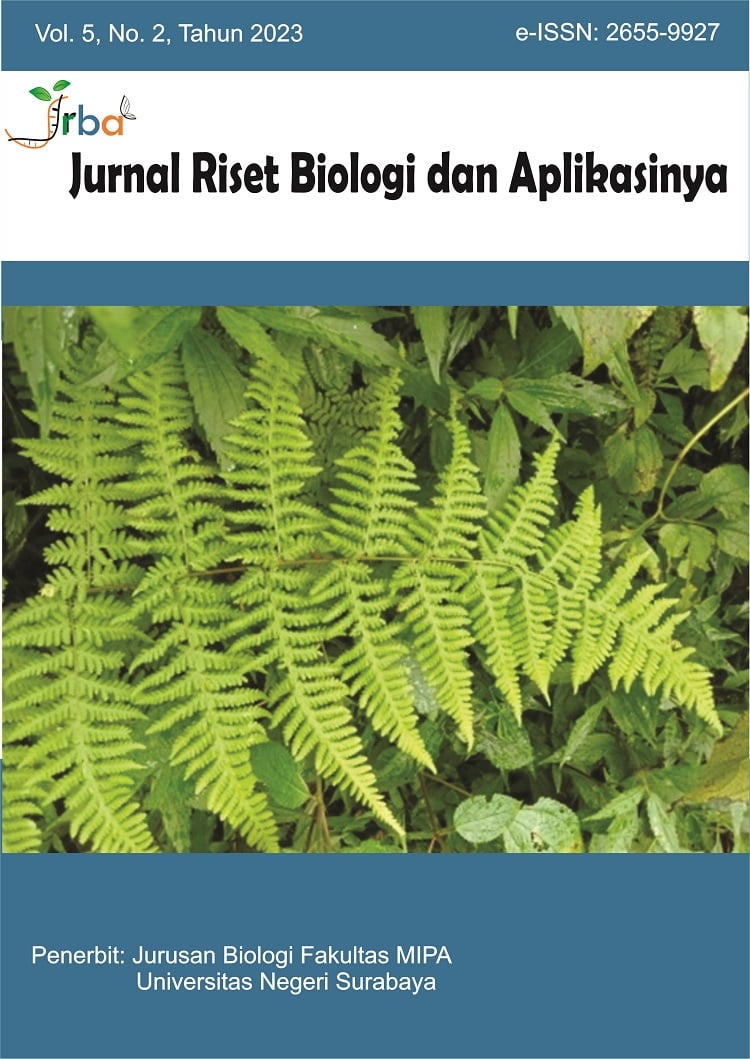Morpho-histological Study of the Rat Spleen Post-Induction of Sodium Nitrite and Acorus calamus L. Rhizome Ethanolic Extract
DOI:
https://doi.org/10.26740/jrba.v5n2.p89-97Abstract
Sodium nitrite (NaNO2) is one of the most inorganic salts and is often used in processed meat products. Long-term consumption of sodium nitrite has been reported to cause of oxidative stress and spleen histological changes. Therefore, anti-oxidative effects are needed from natural ingredients such as Acorus calamus L. The study aims to determine the effect of A.calamus L. rhizome extract on anatomical structure and histological changes in the rat spleen induced with NaNO2. We used a completely randomized design with twenty-five male rats divided into 5 groups. Negative control (NC) was given 0.5% CMC for 40 days; positive control (PC) on days 1-15 was given NaNO2 (50 mg/kg BW); on days 16-30 given (50 mg/kg BW) NaNO2 + 0.5% CMC and on days 31-40 given 0,5% carboxy methyl cellulose (CMC). Treatment 1 (T1), Treatment 2 (T2), and Treatment 3 (T3) on days 1-15 were given NaNO2 doses of 50 mg; and; on days 16-30, groups T1, T2, and T3 were given NaNO2 + extract with each predetermined dose (250 mg/kg BW for T1, 500 mg/kg BW for T2, and 750 mg/kg BW for T3). For days 31-40 groups T1, T2, and T3 were given extracts with each predetermined dose. Results revealed that the extract of the A. calamus L. rhizome affects weight, length, and width of the spleen (P<0.05); and bleeding lesions; while having no noticeable effect (P<0.05) and having a noticeable effect on the area of the white pulp (P<0.05). Administration of ethanol extract of A. calamus L. at a dose of 250 mg/kg BW has an impact on improving spleen length; a dose of 500 mg/kg BW has an impact on the weight and length of the spleen; and a dose of 750 mg / kg BW has an impact on improving spleen length, but the size variation is still in the normal category. While extracts at doses of 250 and 500 mg/kg BW have a repair impact on tissue shrinkage in damaged white pulp.
References
Cesta MF. (2006). Toxicologic Pathology. https://doi.org/10.1080/01926230600867743
Hidayati E, Berata IK, Samsuri S, Sudimartini LM, Merdana IM. (2018). Gambaran Histopatologi Limpa Tikus Putih yang Diberi Deksametason dan Vitamin E. Bul Vet Udayana. 10(1):18. https://doi.org/10.24843/bulvet.2018.v10.i01.p03
Hoffbrand, A. V., Pettit, J. E., Moss PAH. 2001. Essential Haematology (Essentials). Fourth Edi. Oxford: Wiley-Blackwell.
Kumar, V., Abbas, A., Aster J. (2012). Robbins Basic Pathology. Philadelphia, PA: Elsevier.
Mittal N, Varshney VK SB and GH. 2015. High Levels of Diversity in the Phytochemistry, Ploidy and Genetics of the Medicinal Plant Acorus calamus L. Med Aromat Plants. https://doi.org/10.4172/2167-0412.S1-002
Mohammed FF. (2014). Effect of Marjoram Oil on the Clinicopathological, Cytogenetic and Histopathological Alterations Induced by Sodium Nitrite Toxicity in Rats. Glob Vet.(January). https://doi.org/10.5829/idosi.gv.2014.12.05.83186
Muchtaromah B, Ahmad M, S EK, A YM, A VL. (2017). Phytochemicals, Antioxidant and Antifungal Properties of Acorus calamus, Curcuma mangga, and Allium sativum. KnE Life Science, 3(6), 93. https://doi.org/10.18502/kls.v3i6.1119
Petrova E, Gluhcheva Y, Pavlova E, Vladov I, Voyslavov T, Ivanova J. (2020). Effect of acute sodium nitrite intoxication on some essential biometals in mouse spleen. J Trace Elem Med Biol, 58, 126431. https://doi.org/10.1016/j.jtemb.2019.126431
Suparmi S, Fasitasari M, Martosupono M, Mangimbulude JC. (2016). Comparisons of Curative Effects of Chlorophyll from Sauropus androgynus (L) Merr Leaf Extract and Cu-Chlorophyllin on Sodium Nitrate-Induced Oxidative Stress in Rats. J Toxicol, 20(1),123-134. https://doi.org/10.1155/2016/8515089
Suttie AW. (2006). Toxicologic Pathology. https://doi.org/10.1080/01926230600867750
Wahyuningsih SPA, Pramudya M, Putri IP, Savira NII, Winarni D, Suhargo L, Darmanto W. (2017). Okra Polysaccharides Improves Spleen Weight and B-Lymphocytes Proliferation in Mice Infected by Staphylococcus aureus. Biosaintifika, 9(3), 460. https://doi.org/10.15294/biosaintifika.v9i3.11284
Ward, J. M., Mann, P. C., Morishima, H., Frith CH. (1999). Thymus, Spleen, and Lymph Nodes. Vienna: Cache River Prss.
Downloads
Published
How to Cite
Issue
Section
License
Copyright (c) 2023 Jurnal Riset Biologi dan Aplikasinya

This work is licensed under a Creative Commons Attribution-NonCommercial 4.0 International License.
 Abstract views: 379
,
Abstract views: 379
, PDF Downloads: 291
PDF Downloads: 291












